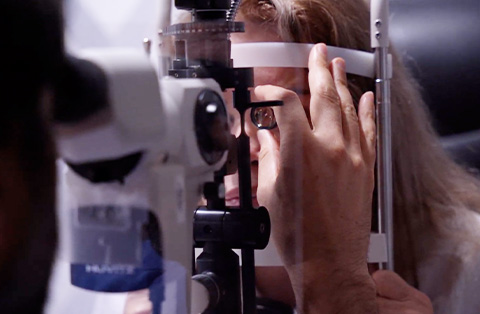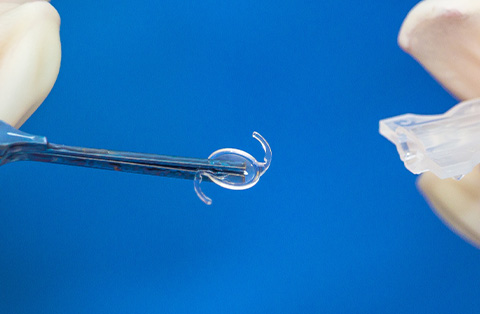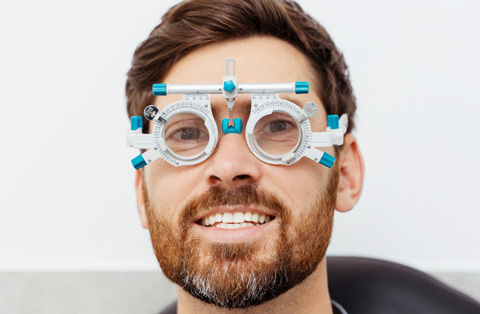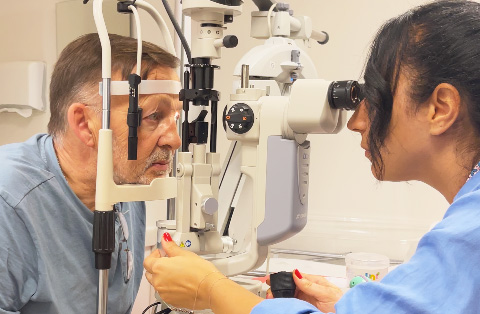What are Cataracts?
Cataracts are a common eye condition where the natural lens of the eye becomes cloudy, leading to blurry or impaired vision. The lens, located behind the iris, is normally clear and helps focus light on the retina, allowing for sharp, clear vision.
Cataracts develop when proteins in the lens break down and clump together, causing the cloudiness. This can make it difficult to see clearly, especially in low light or bright environments. Cataracts can affect one or both eyes, and they typically worsen over time if left untreated. They are most common in older adults but can also result from injury, medical conditions, or certain medications.
What causes cataracts?
Cataracts develop due to a variety of causes, many of which are related to aging and natural changes in the eye. The most common causes include:
Aging: As you age, the proteins in the eye’s lens break down and clump together, leading to cloudiness. This is the most common cause of cataracts.
Genetics: A family history of cataracts may increase the risk of developing them at an earlier age.
Sunlight exposure: Long-term exposure to ultraviolet (UV) rays can damage the proteins in the eye, accelerating cataract formation.
Injury: Eye trauma or injury can lead to cataracts by damaging the lens directly.
Medical conditions: Diabetes is a major risk factor, as high blood sugar can cause lens swelling and changes in its clarity. Other conditions like glaucoma or chronic inflammation also increase the risk.
Medications: Long-term use of corticosteroids can increase the risk of cataracts.
Lifestyle factors: Smoking, excessive alcohol consumption, and poor nutrition are also linked to an increased risk of cataracts.
By understanding these causes, individuals can take steps to reduce their risk, such as protecting their eyes from UV light, managing medical conditions, and maintaining a healthy lifestyle.
What are the symptoms of cataracts?
Cataracts develop gradually, and symptoms may vary as the condition progresses. The most common symptoms of cataracts include:
Blurred vision or cloudy vision: Vision becomes less sharp, as if looking through a foggy window.
Difficulty seeing at night: Low-light situations, such as driving at night, can become challenging.
Sensitivity to light: Bright lights may cause discomfort, and glare may be more noticeable, especially in sunlight or from oncoming headlights.
Seeing halos around lights: Lights may appear to have rings or halos around them.
Fading or yellowing of colors: Colors may appear less vibrant or more yellowed.
Double vision in one eye: You may experience double vision or overlapping images, even when closing one eye.
Frequent changes in prescription: You may need to update your glasses or contact lenses more often due to vision changes.
If left untreated, these symptoms worsen over time, impacting daily activities like reading, driving, or recognizing faces.
How are cataracts diagnosed?
Cataracts are diagnosed through a comprehensive eye examination performed by an ophthalmologist or optometrist. The following tests are commonly used to detect and assess cataracts:
Visual acuity test: This test measures how well you can see at various distances using an eye chart. It helps determine if your vision is impaired by cataracts.
Slit-lamp examination: A special microscope with a bright light is used to examine the structures at the front of your eye, including the cornea, iris, and lens. This allows the doctor to detect any clouding of the lens.
Retinal exam: After dilating your pupils with eye drops, the doctor examines the back of the eye (retina) to check for other eye conditions. A dilated pupil provides a clearer view of the lens, making it easier to spot cataracts.
Tonometry: This test measures the pressure inside your eye. Although primarily used to detect glaucoma, it can be part of a full eye exam to rule out other conditions when diagnosing cataracts.
These diagnostic methods allow your doctor to confirm the presence of cataracts and determine their severity, helping guide treatment options.
Cataract Surgery
Cataract surgery is a common and safe procedure that removes the cloudy lens of the eye and replaces it with an artificial intraocular lens (IOL). This restores clear vision. The surgery is typically performed on an outpatient basis and takes about 15-30 minutes per eye. Here is a detailed explanation of how cataract surgery is performed, along with the different types of surgery:
How Cataract Surgery is Performed?
Preparation:
Anesthesia: Local anesthesia (eye drops or injections) is used to numb the eye. You remain awake but won’t feel pain.
Dilation: Eye drops are used to dilate your pupils, allowing the surgeon access to the lens.
Incision:
Lens Removal:
Phacoemulsification: In most cases, ultrasound energy is used to break up the cloudy lens into small pieces. The surgeon uses a probe to emit sound waves that emulsify (break down) the lens. The pieces are then suctioned out through the incision.
Extracapsular Cataract Extraction (ECCE): In cases where the cataract is too hard or dense, a larger incision may be needed. The lens is removed in one piece, without breaking it up.
Lens Implant:
Closing the Incision:
Post-Surgery:
Types of Cataract Surgery
There are different types of cataract surgery, depending on the techniques used:
Phacoemulsification (Phaco):
This is the most common technique. A small incision is made, and ultrasound energy is used to break up the cataract, which is then suctioned out. It’s minimally invasive and has a quicker recovery time. Phacoemulsification is ideal for most patients with cataracts at varying stages.
Extracapsular Cataract Extraction (ECCE):
Femtosecond Laser-Assisted Cataract Surgery (FLACS):
This is a more advanced version of cataract surgery, where a laser is used to make precise incisions and break up the lens before removal. This method offers greater precision and may improve outcomes, though it can be more expensive than traditional surgery. FLACS may also reduce the need for ultrasound energy, making the procedure gentler on the eye.
Intracapsular Cataract Extraction (ICCE):
Intraocular Lenses (IOLs)
After removing the cataract, an artificial lens is implanted to replace the cloudy lens. There are different types of IOLs:
Monofocal IOLs: Provide clear vision at one distance (usually far). Glasses may still be needed for reading or intermediate tasks.
Multifocal IOLs: Allow for vision at multiple distances, reducing the need for glasses after surgery.
Toric IOLs: Designed for patients with astigmatism, they correct the shape of the cornea for sharper vision.
Accommodating IOLs: Adjust focus for both near and far vision by shifting slightly inside the eye, mimicking the natural lens.
Cost of Cataract Surgery
Cataract surgery is a crucial procedure for restoring clear vision, but it can also be a significant financial burden, especially in countries with high medical costs. Many patients face long waiting times or hefty bills, leading them to search for more affordable options without sacrificing quality of care.
The cost of cataract surgery varies significantly depending on the country, type of procedure, and whether advanced intraocular lenses (IOLs) are used. This article explores the cost factors of cataract surgery, focusing on the growing trend of seeking treatment in Turkey, a destination known for offering high-quality care at lower prices.
How Much Does Cataract Surgery Cost in Turkey?
The cost of cataract surgery in Turkey is one of the most attractive aspects for international patients. On average, cataract surgery in Turkey costs between $1,000 and $2,500 per eye, depending on the clinic, the surgeon’s expertise, and the type of lens used.
This price often includes the surgery, standard monofocal intraocular lens (IOL), pre-operative tests, and post-operative care. For patients who opt for premium lenses, such as multifocal or toric lenses, the price may increase slightly, but it still remains lower than in many other countries.
In Turkey, the cost covers comprehensive care. Many clinics offer all-inclusive packages that may include not only the surgery but also accommodation, transportation, and assistance for international patients, ensuring that everything is handled smoothly from the moment they arrive until recovery. This adds to the affordability, as patients do not have to worry about hidden or additional costs.
For patients looking for laser-assisted cataract surgery, the price will be on the higher end of the spectrum but still cost-effective compared to Western standards.
Is It More Affordable Than Other Destinations?
The cost of cataract surgery is a significant concern for many patients, especially in countries with high healthcare costs. Turkey offers a cost-effective solution, providing high-quality cataract surgery at much lower prices compared to the U.S. or Europe.
With affordable packages, experienced surgeons, and cutting-edge technologies, Turkey has become a leading destination for cataract surgery, making it an ideal choice for those seeking excellent care without the financial strain often associated with the procedure elsewhere.
What Makes Cataract Surgery in Turkey a Popular Choice?
Cataract surgery is a crucial procedure for restoring clear vision, but it can be expensive and difficult to access in some countries. As a result, many people look for more affordable options abroad without sacrificing quality. Turkey has emerged as a leading destination for cataract surgery, offering world-class healthcare at significantly lower prices.
Why Choose Cataract Treatment in Turkey?
One of the biggest reasons people choose Turkey for cataract surgery is affordability. Cataract surgery can be very costly in countries like the U.S., U.K., or Europe, especially if advanced techniques or premium intraocular lenses (IOLs) are involved. In Turkey, patients can access the same high-quality care at a fraction of the cost. The lower cost is largely due to the lower operating expenses in Turkey, not a compromise in quality.
Additionally, Turkey is home to highly trained surgeons who have extensive experience in performing cataract surgeries. Many ophthalmologists in Turkey are internationally trained and follow the latest advancements in medical technology. State-of-the-art clinics are equipped with advanced tools, such as femtosecond laser systems and premium IOL options, ensuring that patients receive the latest and most effective treatments.
Turkey’s medical tourism infrastructure is another major advantage. Clinics and hospitals in cities like Istanbul and Ankara are well-versed in catering to international patients. They offer seamless services, often including translation support, accommodation packages, and even sightseeing opportunities, making the entire experience convenient and stress-free.
How Does Cataract Surgery in Turkey Compare to Other Countries?
When comparing cataract surgery in Turkey to other countries, three main factors come to the forefront: cost, quality, and waiting times.
Cost: Cataract surgery in Turkey is significantly more affordable than in many Western countries. For example, a cataract procedure in the U.S. can cost between $3,000 and $5,000 per eye, whereas in Turkey, it ranges from $1,000 to $2,500, depending on the type of lens and technique used. Despite these savings, the standard of care remains very high.
Quality of Care: Turkish cataract surgeons use the same technologies and techniques found in leading Western hospitals, including phacoemulsification and laser-assisted surgery. Many doctors in Turkey are trained or have practiced in Europe or the U.S., ensuring that international standards of care are met. The use of premium IOLs, such as multifocal or toric lenses, is also widely available in Turkey, ensuring patients can achieve optimal visual outcomes.
Waiting Times: In some countries with public healthcare systems, patients may face long waiting times for cataract surgery. In contrast, clinics in Turkey offer immediate access to surgery. This can be crucial for patients who need quick treatment to prevent further vision loss or maintain their quality of life.
What is the Reputation of Turkish Cataract Surgery Clinics?
Turkey has built a strong reputation in the field of cataract surgery, thanks to its high-quality clinics and experienced surgeons. Many Turkish ophthalmology centers are accredited by international bodies, ensuring they adhere to global standards of safety and patient care. Clinics in major cities like Istanbul, Izmir, and Antalya are equipped with modern surgical technologies, making them comparable to, or even exceeding, many facilities in Western countries.
Furthermore, many clinics in Turkey specialize in treating international patients, with multilingual staff and tailored services that accommodate the specific needs of medical tourists. These clinics often offer all-inclusive packages, which cover consultation, surgery, post-operative care, and sometimes even accommodation and transportation. This attention to detail has earned Turkey a positive reputation as a top destination for medical tourism, particularly in eye care.
Patients also appreciate the personalized approach that many Turkish clinics offer. Unlike some larger, high-volume facilities in other countries, Turkish eye clinics often provide more one-on-one care. Surgeons take the time to understand each patient’s unique vision needs and offer customized solutions, whether that means selecting the right type of IOL or using advanced surgical techniques to achieve the best results.
Cataract Surgery Recovery
While the surgery itself is quick, recovery can take a few weeks, during which patients need to follow specific guidelines to protect their eyes and promote healing.
What to Expect Immediately After Surgery?
Immediately after cataract surgery, you will likely notice that your vision is blurred or cloudy, which is normal. As your eye begins to heal, your vision will gradually improve. You may also experience mild discomfort, such as itching, a feeling of grittiness, or slight sensitivity to light. These symptoms typically subside within a few days. You will be given a protective shield or sunglasses to wear, especially when going outside, to prevent irritation from bright light and dust.
Most patients are able to go home the same day as the surgery, but you will need someone to drive you home. Your doctor will likely prescribe eye drops to prevent infection, reduce inflammation, and help with healing. It is important to use these drops as directed to avoid complications.
Timeline for Recovery
First 24-48 Hours: In the first couple of days after surgery, you will likely experience blurry vision, but you may already start noticing some improvement. Your eye may feel sore, and you should avoid rubbing it. Some patients notice clearer vision the next day, but for others, it may take a little longer.
First Week: During the first week, your vision will gradually become clearer as your eye heals. Follow-up appointments with your doctor will be scheduled to ensure the eye is healing properly. Most patients are able to resume light activities like watching TV, reading, or using a computer, but it is important to avoid strenuous activities like heavy lifting, bending over, or exercise.
4-6 Weeks: Full recovery usually takes around four to six weeks. During this time, your vision continues to sharpen, and any minor discomfort should completely resolve. Most patients are able to resume normal activities, including driving, after the first week or two, as long as your vision meets the legal requirements for safe driving.
Post-Surgery Care Guidelines
To ensure a smooth recovery and avoid complications, follow these post-operative care instructions:
Avoid touching or rubbing your eye: Rubbing the eye can increase the risk of infection or dislodge the protective flap created during surgery.
Use prescribed eye drops: These drops help reduce inflammation and prevent infection. Use them exactly as directed by your surgeon.
Protect your eye: Wear the protective shield or glasses provided, especially when sleeping or going outside, to avoid accidental bumps or exposure to irritants.
Avoid water in your eye: For the first week, avoid getting water in your eye, especially when showering or washing your face, as this could introduce bacteria and increase infection risk.
Avoid strenuous activities: For at least a week, avoid heavy lifting, bending over, or intense physical exercise, which could increase pressure in your eye and slow healing.
If you want to learn more about post-surgery care and how to train your eyes after surgery for faster recovery read our article here!
Potential Complications and When to Call Your Doctor
Cataract surgery is generally safe, but like any procedure, it carries some risk. If you experience any of the following symptoms, contact your doctor immediately:
Severe or persistent pain: Mild discomfort is normal, but severe pain could indicate a problem.
Sudden vision loss: While vision may be blurry at first, a sudden or dramatic loss of vision should be addressed right away.
Increased redness or swelling: Mild redness is common, but if it worsens or doesn’t improve, it could be a sign of infection.
Flashes of light or floaters: These could indicate retinal issues that need immediate attention.
Long-Term Outlook After Recovery
Once fully healed, cataract surgery offers permanent results, as the artificial lens placed during surgery does not cloud over like a natural lens. However, some patients may develop a condition called posterior capsule opacification (PCO), where the membrane behind the lens becomes cloudy. This is easily treated with a quick, painless laser procedure called YAG laser capsulotomy.
After surgery, many patients find they have improved vision that allows them to reduce their dependence on glasses, especially if premium intraocular lenses were used. However, some may still need reading glasses or glasses for specific activities.



